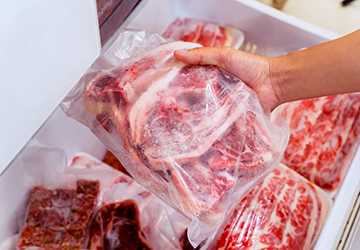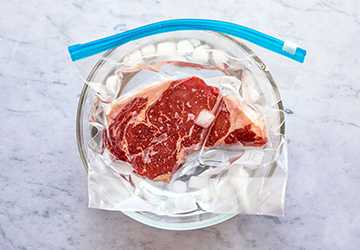Have you ever opened your fridge only to find that the expensive steak you bought has turned an odd colour? You're not alone. This is a common issue that many people face when storing meat and is far more widespread than one might imagine.
When meat becomes spoiled, it is about more than losing money and food that could have been consumed. To be more precise, it can make you sick.

No one would like to spend a night close to the wash basin hugging the toilet due to the wrong way of storing a chicken breast.
But don't worry! This blog post will save your meat and your stomach. Let's review some essential tips to help you maintain your meat in the best possible condition.
Let's get started and prevent good meat from spoiling!
To ensure that you do not compromise the quality of the meat, ensure that it is stored in the coldest part of the refrigerator, which is the lowest shelf.
It's like finding the right place to put your meat in a theatre. Check that your fridge is cold enough – it should be at 40°F or lower.
This cold climate reduces bacterial growth rate, preserving the quality and taste of your meat for a long time.
Imagine it as providing your meat with a comfortable place to be while it waits for cooking, like a meat spa.
Tightly pack your meat so that it does not go wrong. If you have them, use containers that do not let air in or vacuum bags. If not, plastic wrap or aluminium foil is also recommended.
The idea is to exclude air from your meat. It's like putting it to bed, or as we would say in Texas, 'putting it to bed.'
This wrapping technique helps ensure that meat does not dry or take on the smells of other foods in the refrigerator.
When the piece of meat is well wrapped, it remains juicy and tasty when ready to take it.
Freezing meat can be compared to putting meat on pause or freezing its freshness. Storing the leftovers in strong freezer bags or vacuum-sealed containers is recommended to minimise freezer burn.
It can preserve your meat for months and will not require you to frequent the stores. Of course, freezing preserves the moment for your meat, but it does not rewind time.
Thus, it is advisable to freeze meat when fresh to achieve the best results.
Always be a detective with your meat by marking it with the date. Use the "first in, first out" principle – it is not wine, so the longer it has been stored, the better it is not.
This simple habit helps one know what needs to be cooked next and what can only wait for later. It is like coming up with a schedule for how you want your meat to be prepared, from when it was bought until it is ready to be consumed, even if it is left at the back of the fridge.
A quick label can help prevent you from having to guess what it is later and the possibility of it getting thrown away.
Never thaw meat at room temperature – inviting all the bacteria for a party. However, let it cool down in the refrigerator.

Plan: Allow every 5 pounds added to rest for a day. This is a time-consuming affair but very effective in ensuring safety. If you do not have the time, though, cold water thawing is the next best thing.
Indeed, safe thawing can be viewed as a patience game—the payoff is tasty, safe meat.
Raw and cooked meats should be stored like two children fighting. Always ensure that different foods are stored in various containers and that different cutting boards are used for other foods.
It is your best protection against cross-contamination, the silent killer responsible for most food-borne diseases.
It is making specific compartments in your fridge safe or secure zones. This is a primary method of avoiding cross-contamination and protecting your tummy and food.
In the world of meat storage, it is always best to keep things as segregated as possible!
Respect your fridge as one of your most valuable assets. Periodically, measure its temperature to check that it is cold enough.
It is advised to clean it often to remove any bacteria hiding in the machine. It is like having a check-up on your refrigerator that stores your meat.
Fresh meat is happy meat, and your meat is satisfied in a clean, cold fridge. This little effort goes a long way in preserving the freshness and quality of your food.
It is like washing your hands before eating or cleaning your face before bed; these are all simple things that greatly help.
Are you ready to improve your meat storage? Do not procrastinate—begin right now! These are some of the small changes that can brighten up one's life.
You will use less electricity, keep your meat fresher, tastier, and safer to consume, and spend less on food that spoils and more on food that will last long on the shelves. It's a win-win!
No more disappointing dinners because your meat is spoiled. Simply delicious, safe food when you need it.
Well, then, it is time to use these tips. Your palate and, of course, your pocket will be very grateful for them. Happy storing!